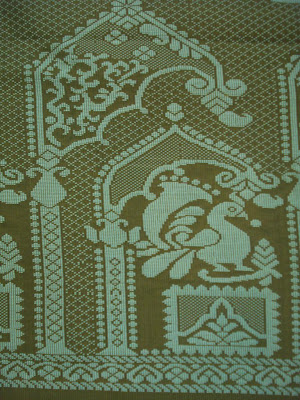The Sari
 The sari is the traditional garment of an Indian woman. It is an unstitched
piece of cloth, which varies from five to nine yards in length and can be worn
in different styles. A sari is worn over a petticoat and a short-sleeved
midriff-baring blouse. The most popular style of wearing a sari is by tucking
one end into the petticoat at the waist while a major portion of it is pleated
neatly and tucked in the front. The rest of the sari, which is known as the
pallu or pallav is taken over the left shoulder. The pallu is the most
fascinating and striking feature of a sari, it is often heavily embellished
with woven motifs or embroidery.
The sari is the traditional garment of an Indian woman. It is an unstitched
piece of cloth, which varies from five to nine yards in length and can be worn
in different styles. A sari is worn over a petticoat and a short-sleeved
midriff-baring blouse. The most popular style of wearing a sari is by tucking
one end into the petticoat at the waist while a major portion of it is pleated
neatly and tucked in the front. The rest of the sari, which is known as the
pallu or pallav is taken over the left shoulder. The pallu is the most
fascinating and striking feature of a sari, it is often heavily embellished
with woven motifs or embroidery.However, this authentic Indian garment has lost some of its popularity as daily wear in the recent past. The western outfits have made an inroad into the Indian woman’s wardrobe due to a shift towards rapid globalization and emerging corporate culture. Today, women prefer to wear clothes that offer ease of movement in addition to style. Also, with the boom in the retail industry Indians have a wider variety of options to pick and choose from and women are being increasingly seen in designer outfits western style outfits.
The Saris of Indian Subcontinent:
This elegant drape of India comes in varied textures and
styles. For most formal occasions one finds women both the middle-class and the
elite looking their best – in a graceful sari! The materials may vary from
crisp cottons, rich silks to synthetics and chiffons, but the final overall
look is simply elegant and matchless.
Some familiar regional styles of wearing a sari:
Shantipuri:
Shantipur, a small town situated in the Nadia district of West Bengal is famed for its fine cotton saris. These saris are woven on the looms by the taantis (weavers) of the town and come in soft colours. Once upon a time, the Shantipuri dhuti (the rectangular piece of unstitched garment for men) were preferred by all Bengali bridegrooms and their relatives.
Bengali Sari:
In the traditional Bengali style, the sari is draped around the body without pleats and the pallu is left loose by hanging over the left shoulder often with a bunch of keys attached to it. The earlier generations of Bengali women preferred the style because of its sheer simplicity and utmost comfort.

Dhakai Sari:
The dhakai jamdani sari originated in the region now known as Bangladesh and is made with superior quality cotton. It was originally woven as the legendary dhakai muslin and woven with beautiful, eye-catching patterns.
Tangail Sari:
Tangail is a district in what is today known as Bangladesh. The traditional tangail saris have borders with the lotus or a lamp pattern. These are now being made in the Phulia district of West Bengal.
Maharashtrian Sari:
A nine-yard sari called the nawwadi is the traditional style
very similar to the men’s dhoti. The pleats of the sari are placed between
the legs and tucked in the centre back. Fisherwomen in the coastal regions of
Maharashtra still wear a nawwadi and well, it is worn without a petticoat!
Nivi/Madrasi Sari:
This style is very similar to the Maharashtrian nawwadi or
the nine-yard sari. The pallu is quite long and wrapped around the waist and
tucked in.
Gujarati Sari:
The Gujarati woman sports a distinctive style, as she wears a sari with a neatly pleated pallu brought in front over the right shoulder with one end tucked around the waist to the left.

Banarasi Sari:
These saris are made of finely woven silk and have intricate
designs done in golden thread (zari). Benarasi saris are relatively heavy and
worn by Indian women on important occasions. The trousseau of any Indian bride
is deemed incomplete without the customary red Benarasi sari. In fact in most
states the Benarasi is the sari that the bride wears for the wedding ceremony.

Baluchari Sari:

Baluchari Sari:
The Baluchari sari of
Vishnupur in West Bengal is made of silk and woven on special looms. The
borders and pallu of the sari are very striking because of its use of intricate
thread work to depict stories from the Mahabharata and Ramayana.
Chanderi Sari:
Chanderi Sari:
Chanderi, a small town located in Madhya Pradesh has long
been famous for its hand woven sarees. Silk or cotton is used to make a
chanderi which is combined to create beautiful saris with artistic borders that
are practically weightless. They generally have a rich gold border and the
exclusive ones have gold checks with butis (round shaped motifs) all over.
Pochampally Sari:
Located in Andhra Pradesh, Pochampally is famous for its rich saris in both cotton and silk incorporating traditional ikat weaves. Ikat is the name given to a weaving technique which makes use of the tie-dye process. In this method, the yarn is first dyed and then sent for weaving.
Paithani Sari:
Paithani Sari:
In Maharashtra, a woman’s wardrobe is deemed incomplete without the inclusion of the Paithani of Paithan, a small town near Aurangabad. The hand-woven silk sari comes with an ornamented pallu with zari work and is considered to be a collector’s item. The style of the sari is characterized by the pallus with peacock designs and exclusive motifs such as flowers, fruits and birds.
Taant Sari:
Taant Sari:
The word literally means ‘made on the loom’, Taant is the traditional sari of Bengali women in India. Popularly known as Bengal cotton, taant is hand-woven in various districts of West Bengal. These saris come in a variety of colours with simple yet beautiful designs.
Kantha Sari:
Literally speaking, kantha is a style of embroidery that
uses the simple running stitch which is nothing but passing the needle in and
out of the fabric to produce beautiful floral or abstract patterns. Did you
know that it all started as a form of recycling of old cloth to produce the
traditional quilts and bedspreads made from old saris and large pieces of used
cloth. This type of embroidery was an art practiced by Bengali women in their
spare time. In the small town of Bolpur in West Bengal, famous for producing
saris with kantha embroidery, each sari is a labour of love, taking a long time
to complete, as much depends on the skill and precision of the artisans.
Dhonekhali, and Begumpuri are other popular styles of saris made on handlooms in Bengal. Dhonekhali is known for its stripes and checks. Bengal being a coastal state, the fish is a much loved and commonplace motif. Consequently Dhonekhali sarees often depict rows of fish running across in horizontal stripes throughout the piece of textile. Over the years, the distinctive patterns have merged as weavers started experimenting with various combinations of design and yarn, so much so, it is now difficult to distinguish between the various styles, unless one is an expert on texture.
Kanjeevaram Sari:
Dhonekhali, and Begumpuri are other popular styles of saris made on handlooms in Bengal. Dhonekhali is known for its stripes and checks. Bengal being a coastal state, the fish is a much loved and commonplace motif. Consequently Dhonekhali sarees often depict rows of fish running across in horizontal stripes throughout the piece of textile. Over the years, the distinctive patterns have merged as weavers started experimenting with various combinations of design and yarn, so much so, it is now difficult to distinguish between the various styles, unless one is an expert on texture.
Kanjeevaram Sari:
These are considered
to be the most spectacular and exclusive silk saris of India. The little town
of Kancheepuram near Chennai has been making these saris for over 400 years.
Woven in brilliant colours and the designs Kanjeevarams are influenced by the
paintings in the Pallava temples and palaces. The most striking characteristic
of a Kanjeevaram is its zari ( thread made of fine gold or silver) work done on
pallus and borders of the sari. Not surprisingly, the more the zari work the
more expensive will be your Kanjeevaram! In recent times, Kanjeevarams are
being experimented with patterns from the Ramayana, Mahabharata and the Bhagwad
Gita.
Mysore Silk Sari:
Mysore silk saris of Karnataka are famous for their
traditional designs and colors. The zari work on the pallus and borders
add to the sophistication and elegance of these saris. Mysore silk saris
are considered to be very durable and can be washed and worn as often as
required.
Maheshwari Sari:
Hailing from Madhya Pradesh, this sari
has a natural sophistication that is difficult to match. The speciality of
these saris is its unique striped and chequered patterns on silk and cotton
fabrics. The pallu of a Maheshwari sari bears five stripes, three coloured and
two white.

Narayanpet: Narayanpet, a small town in Andhra Pradesh is a significant sari manufacturing centre. These saris come in both silk and cotton and are well known for their gorgeous zari borders with rudraksh (a special type of fruit) motifs. The pallu in these saris are very attractive with alternating coloured bands.

Narayanpet: Narayanpet, a small town in Andhra Pradesh is a significant sari manufacturing centre. These saris come in both silk and cotton and are well known for their gorgeous zari borders with rudraksh (a special type of fruit) motifs. The pallu in these saris are very attractive with alternating coloured bands.
Venkatgiri Sari:
Venkatgiri is a small town in the Nellore district of Andhra Pradesh. Known for its fine cotton saris which go by the same name, it is a perfect wear for the Indian summer. The main characteristic of these saris are their beautiful jewel-like colours.












































.jpg)































